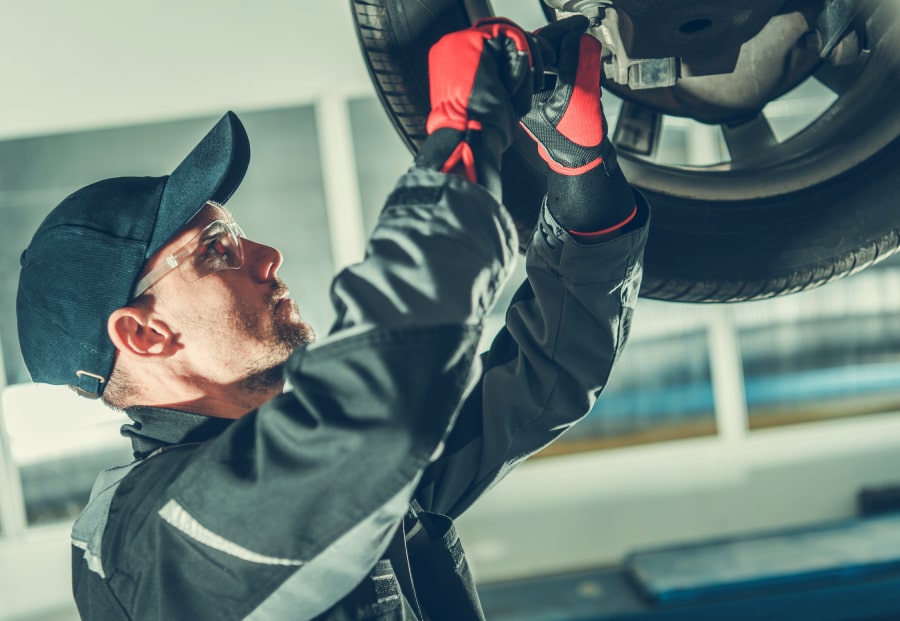Know the Difference Between Your Car’s CV Joints & Ball Joints
Date Posted: 4 October 2023

When it comes to intricate vehicular components, two parts that often get mixed up are CV joints (found on both ends of a CV driveshaft) and ball joints. Although both play essential roles in your car’s suspension and drivetrain, they actually perform different functions. In this guide, we’ll explore the differences between these components, what they do and how to identify issues with them.
CV Joints (Constant Velocity Joints)
CV joints, or constant velocity joints, are integral parts of a vehicle’s drivetrain system, particularly in front-wheel-drive and all-wheel-drive vehicles. These joints connect the transmission to the wheels and enable power to be transferred efficiently while accommodating the up-and-down motion of the suspension. There are two common types of CV joints: the inner CV joint, which connects to the transmission, and the outer CV joint, which connects to the wheels.
Function of CV Joints
The primary function of CV joints is to maintain a constant velocity—hence the name. This means that as your car’s suspension moves up and down, the CV joints ensure a steady and consistent transfer of power from the transmission to the wheels. This allows your vehicle to maintain a smooth and uninterrupted ride while negotiating turns and bumps in the road. CV joints also hold the drive shaft in place.
CV joints are engineered with a flexible rubber boot that protects them from dust, dirt and contaminants. Regular inspection and maintenance of these boots are essential to prevent premature wear and tear.
Ball Joints
Ball joints are crucial components of a vehicle’s suspension system, connecting the steering knuckle to the control arms. They play a pivotal role in controlling the movement of the wheels and allowing for smooth steering and handling. Ball joints are typically found in both the front and rear suspension systems of most vehicles.
Function of Ball Joints
Ball joints provide the pivot point between the steering system and the wheel. They allow the wheels to move up and down while simultaneously allowing them to turn left and right for steering. Ball joints need to be robust and flexible to withstand the constant forces they endure while driving, especially during cornering and steering.
Unlike CV joints, ball joints are not responsible for transmitting power; their primary function is to ensure proper wheel alignment and maintain steering control.
Key Differences Between CV Joints and Ball Joints
Function
CV joints are responsible for transferring power from the transmission to the wheels while accommodating suspension movement. Ball joints, on the other hand, provide pivot points for steering and wheel alignment.
Location
CV joints are found in the drivetrain, connecting the transmission to the wheels. Ball joints are located in the suspension system, connecting the control arms to the steering knuckle.
Type of Movement
CV joints allow for power transmission and adapt to the suspension’s up-and-down motion. Ball joints facilitate the wheels’ vertical movement for suspension and steering control.
Maintenance
CV joints are protected by flexible rubber boots that need regular inspection and maintenance. Ball joints require proper lubrication and are prone to wear and tear due to their constant movement.
Troubleshooting & Maintenance
Proper maintenance and timely identification of issues with both CV joints and ball joints are essential for your car’s safety and performance.
CV Joint Issues
- Clicking noise: A common sign of a failing CV joint is a clicking or popping noise when turning, especially during sharp turns. This indicates that the CV joint’s protective boot may be damaged, allowing contaminants in and grease to escape.
- Vibration: If you feel vibrations or shuddering while accelerating, it could be due to a damaged CV joint.
- Torn boots: Inspect the CV joint boots regularly for cracks, tears or damage. You should promptly replace a damaged boot to prevent further issues.
Ball Joint Issues
- Clunking noise: Worn-out ball joints often produce a clunking noise, especially when driving over bumps or making turns.
- Uneven tyre wear: If your tyres show uneven wear patterns, it could be a sign of a misaligned or damaged ball joint.
- Steering problems: Steering difficulty or a feeling of looseness in the steering wheel may indicate a problem with the ball joints.
- Visible damage: Visually inspect the ball joints for any signs of physical damage or wear, including looseness or play in the joint.
Need Assistance? We Can Help at Machter
Understanding the difference between your car’s CV joints and ball joints is crucial for proper maintenance and identifying potential issues. Furthermore, regular inspection and timely maintenance of both these components will ensure the safety and longevity of your vehicle. If you ever notice any of the aforementioned signs of trouble with either your CV joints or ball joints, you can always reach out to one of our staff members for an expert opinion. From CV joints and driveshafts to ball and universal joints, we have the parts you need to keep your car running smoothly. Hit up Machter for specialist advice and all the aftermarket car parts you’ll ever need!





